Are you wondering if a set of dumbbells is enough to get BIG? Then you’ve found the right post. Because today, I’ll be explaining why and how it’s possible to build muscle using only dumbbells.
It is possible to build muscle using just dumbbells. It is essential to progressively add weight with time to keep the muscles challenged. A caloric surplus diet and a high protein intake are also required to fuel the muscle growth process.
Dumbbells helped me to gain 40 pounds of muscle myself.
So I know they work!
But how heavy a dumbbell do you really need? And how exactly can you use them to get big?
Keep reading to find out!
Can You Build Muscle Using Only Dumbbells?
Dumbbells are a popular type of free weight, loved by many.
They invariably make an appearance in every lifter’s training program, and are often combined with weight machines and barbells.
But can you really build muscle with JUST dumbbells alone?
| Group | Opinion |
|---|---|
| Personal | Yes |
| Public | Yes |
| Experts | Yes |
| Science | Yes |
1) My Opinion.
Most definitely!
I gained over 40 pounds of muscle myself as an ex-skinny guy who weighed a meager 125 pounds.
I’m currently hovering between 160-170 pounds at 10% body fat. And dumbbells accounted for around 50% of my training to reach this achievement.

Due to the 2020/2021 COVID gym restrictions, I had to make do with a pair of 55 pound dumbbells. And this was enough for me to MAINTAIN my muscle.
So if you’re currently a skinny beginner, I’m confident you’ll be able to BUILD muscle with a set of dumbbells.
Check out my other article to find out if dumbbells are worth the money!
2) Public Opinion.
To find out public opinion, I tracked down this Reddit poll:
“Has anyone seen good results with a dumbbell only workout plan?“
Then I filtered the junk, compiled the results, and here they are:
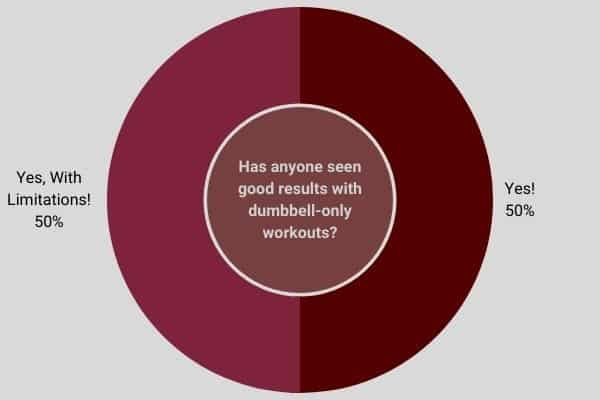
100% of the 14 total responses were positive.
Everyone agreed that you can build muscle with nothing but a set of dumbbells (you can check out my other post to find out how it’s possible to quickly gain 10lbs in a month).
Furthermore- out of the 100% positive responses:
- 50% of people straight out agree that dumbbell-only workouts are a great way to build muscle.
- 50% of people agree dumbbells are great, but you should also be aware of their limitations.
So here are the most commonly quoted limitations of dumbbell-only training:
- Need a bench- to gain full range of motion and maximize training potential.
- Limited weight capacity- makes it difficult to build big legs (which are large muscles and require more weight).
- Large weight increments- of 5 pounds per dumbbell limit progression rate, compared to barbells which allow for smaller weight increments.
- Difficulty in gripping heavy weights- makes it difficult for beginners to develop a solid strength foundation.
You may also be interested in my other post to find out what dumbbell weight you need to gain muscle.
3) Expert Opinion.
Now, here are the opinions of 3 different Certified Strength and Conditioning Coaches:
From beginner to advanced, it doesn’t matter what level of fitness you have, dumbbells are a great home workout option to help you build muscle and get in shape quickly.
Jeff cAVALIERE, ATHLEAN-X
- Jimmy Pena from Muscle And Performance says that a pair of adjustable dumbbells and a bench are a perfectly good way to get an effective workout at home.
- Patrick Striet from Force Fitness notes that dumbbell exercises are a great way to stimulate your muscle fibers for growth.
- Jeff Cavaliere (C.S.C.S) from Athlean-X explains that total body dumbbell workouts are suitable for people of all training levels to build muscle at home.
So dumbbells have been vetted by professionals!
You can also go to my other post to find out the ideal dumbbell weight for beginners.
4) Scientific Opinion.
Scientific research also supports the use of dumbbells to gain muscle.
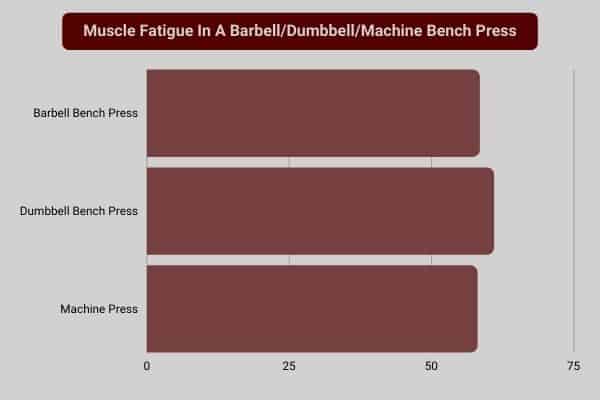
This 2016 study took 19 men and made them perform the bench press using dumbbells, a barbell, or a smith machine.
The scientists then measured each participant’s fatigue index (how quickly they tire).
As you can see, dumbbells are just as good as a barbell or weight machine to fatigue your muscles (indicating a good workout).
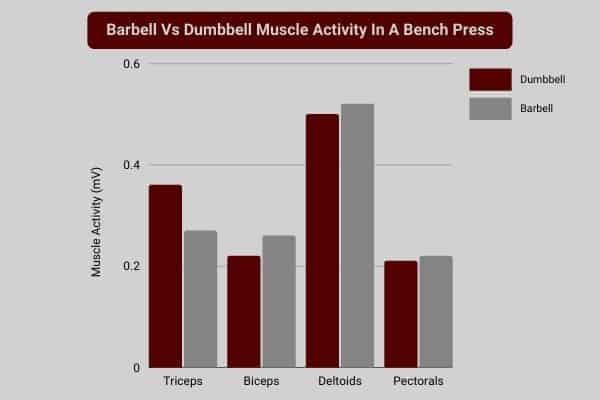
Furthermore, this 2011 study took 12 men and also made them perform the bench press using dumbbells, barbells, or weight machines.
The scientists then measured muscle activity in the chest, arms, and shoulders.
As you can see, dumbbells are just as good as a barbell in activating the chest (pectoral), shoulder (deltoid), and arm (bicep/tricep) muscles!
So the dumbbells have been approved by scientific research!
You can also read my other post for a dumbbell vs barbell bench press weight comparison!
How to Build Muscle With Just A Pair Of Dumbbells
Now I will show you HOW to build muscle if all you have is a set of dumbbells.
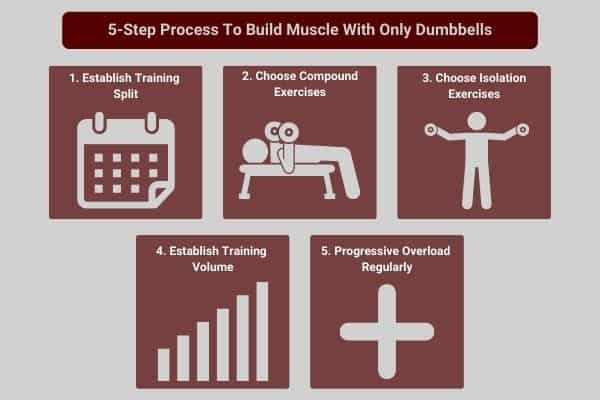
Step 1: Establish Training Split.
A training split refers to the number of training days completed in a week. There are many types of training split. Each one will target different muscle groups at different times over the course of the week, allowing each muscle to be trained and rested accordingly.
Here are 3 of the most common training splits for beginners:
- Push/pull/leg (PPL) split- each training day concentrates on pushing (chest, shoulders, triceps), pulling (back, abs, biceps), or leg workouts. It’s usually completed over 6 workouts per week, allowing each muscle group 48 hours of rest before being worked again.
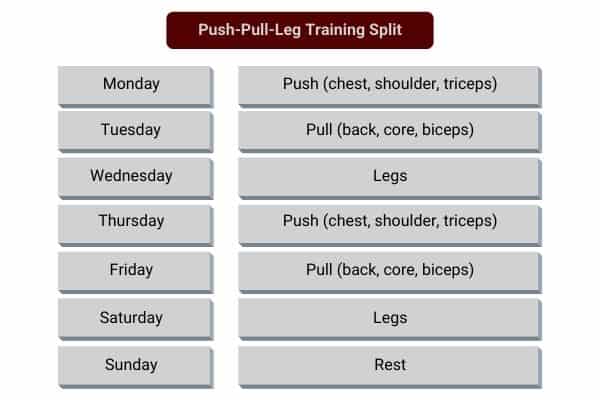
- Muscle group split- each training day concentrates on one or two muscle groups (chest, shoulders, arms, back, abs, and leg). It’s usually completed over 5 or 6 training days, allowing each muscle group to rest for 48 hours.
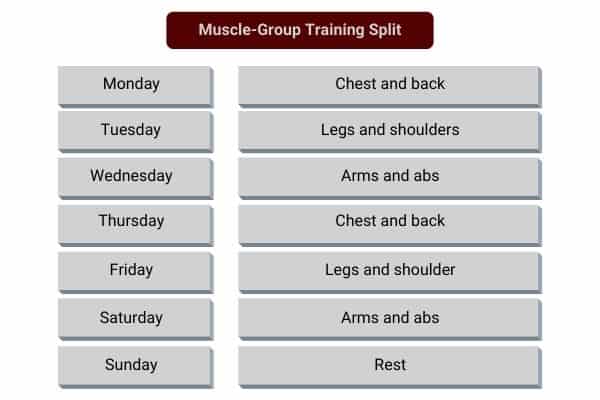
- Full body split- each training day works all the muscles in your body. It’s usually restricted to 3 or 4 training days per week, allowing at least 24 hours of rest for each muscle group. Although this split involves less training days, each workout will be longer.
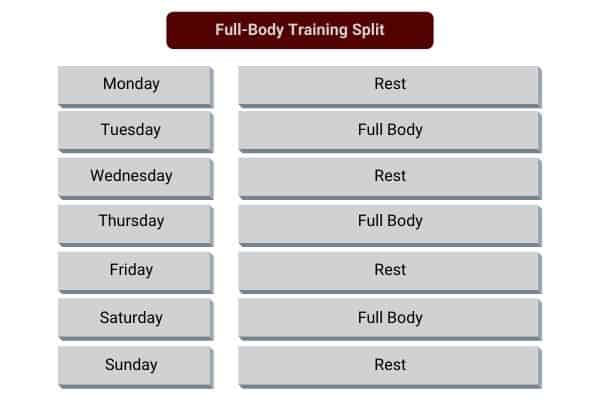
If you are a skinny beginner, I would recommend choosing a 3-day full-body split and increasing to 4 or 5 days as your body adapts.
Another good option would be to start with a 3-day full-body split, and change to a 6 day push-pull or muscle-group split once your body has adapted to training.
Both training splits would work for a beginner. But the important thing is to steadily increase your weekly workload. And this will promote muscle growth as well as prevent overworking of your muscles.
Step 2: Choosing Compound Dumbbell Exercises For Beginners.
Dumbbell compound exercises simultaneously engage multiple muscle groups and joints within a single movement. These include pressing and pulling movements such as the bench press and row. They are an effective way for trainees of all training levels to build overall muscle strength and mass.
If you’re a beginner, compound exercises should be the focal point of your dumbbell workouts.
Examples of compound exercises include:
| Compound Exercise: | Muscles Worked: | Joints Involved: |
|---|---|---|
| Flat dumbbell bench press | Chest, arms, shoulders | Elbows, shoulders |
| Incline dumbbell bench press | Chest, arms, shoulders | Elbows, shoulders |
| Dumbbell pull over | Chest, arms, shoulders, back | Elbows, shoulders |
| Dumbbell shoulder press | Shoulder, arms | Elbows, shoulders |
| Bent-over dumbbell row | Back, arms, core | Elbows, shoulders |
| Dumbbell high-pull | Back, shoulders, arms, core | Elbows, shoulders |
| Dumbbell deadlift | Leg, back, shoulders, core | Hips, knees, ankles |
| Dumbbell goblet squat | Leg, back, shoulders, core | Hips, knees, ankles |
You can go to my other post for a full-body home dumbbell workout to build muscle as a beginner.
Step 3: Choosing Isolation Dumbbell Exercises For Beginners.
Dumbbell isolation exercises engage a single muscle group and joint in a single movement. These include curling, flying, and limb extension movements such as the bicep curl and chest fly. They are an effective way for trainees of all training levels to increase volume in specific muscles.
If you’re a beginner, isolation exercises are a great accessory to compound exercises.
But you should always prioritize the compound exercises first.
In other words- build your isolation exercises AROUND your compound exercises.
Examples of isolation exercises include:
| Isolation Exercise: | Muscles Worked: | Joints Involved: |
|---|---|---|
| Dumbbell chest fly | Chest | Shoulders |
| Dumbbell crossover | Chest | Shoulders |
| Lateral raise | Shoulder (side) | Shoulders |
| Front raise | Shoulder (front) | Shoulders |
| Bicep curl | Biceps | Elbows |
| Tricep extension | Triceps | Elbows |
| Reverse dumbbell fly | Back | Shoulders |
| Dumbbell leg curl | Hamstrings | Knees |
| Dumbbell leg extension | Quadriceps | Knees |
Step 4: Establish Dumbbell Training Volume
Establishing dumbbell training volume requires you to determine the weekly number of sets, reps, weight, and frequency for your exercises. Optimizing training volume will ensure you are providing enough stimulation to your muscles, but at the same time, not overtraining. This maximizes muscle growth potential.
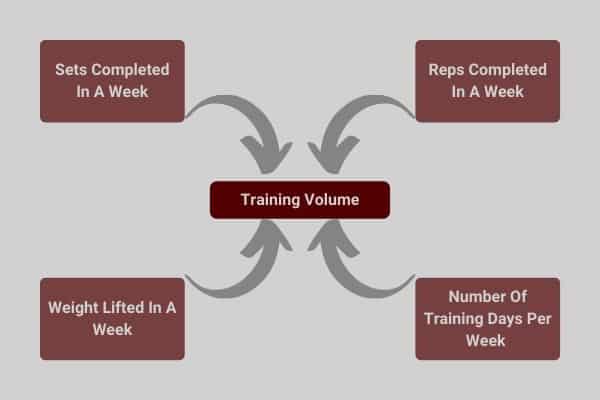
So what is the perfect training volume for a beginner to build muscle with dumbbells?
- Sets- 12 to 24 sets per muscle group per week. This works out to be around 3 to 5 sets of 2 to 3 exercises per muscle group per workout.
- Reps- compound exercises should be done with 6 to 12 reps per set and isolation exercises should be done with 8 to 15 reps per set.
- Weight- compound exercises should be lifted at 80% of your maximum lifting capacity and isolation exercises should be lifted at 70% of your maximum lifting capacity. Maximum lifting capacity is also commonly called a “1 rep max”.
- Workout Frequency- a minimum of two workouts per week per muscle group.
- Rest- 1 to 2 minutes between sets and 24 to 48 hours per muscle group between training days.
- Workout duration- aim for 45 to 60 minutes per workout. Over 80 minutes is too much. This assumes you are actually training at a high intensity and not talking or scrolling IG!
By following these training volume rules, you will ensure maximum hypertrophy (muscle growth) from your dumbbell training!
Step 5: Progressive Overload With Dumbbells
Progressive overloading with dumbbells can be achieved by increasing the weight, number of reps and sets, training frequency, or time-under-tension for a dumbbell exercise. By increasing workload, your muscles will adapt and grow. This makes progressive overload essential to gain muscle with dumbbells.
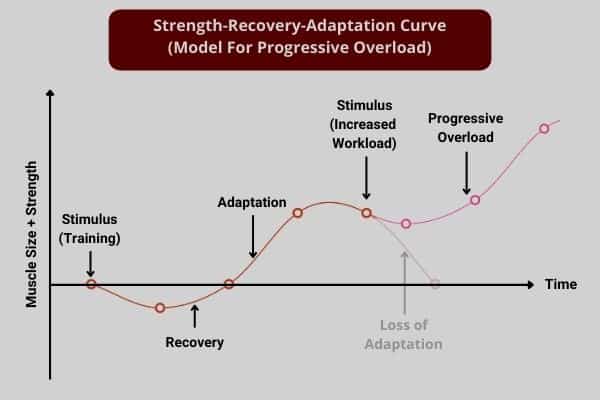
The progressive overload principle can be easier explained with the strength-recovery-adaptation model (see above).
As you can see, overloading a muscle presents it with a new stimulus.
And this forces the muscle to adapt, allowing it to grow.
It’s important to realize that without regular overloading, your muscle won’t grow!
So here’s how to progressive overload with dumbbells:
| Dumbbell Progressive Overload Method | How To Do It | Example |
|---|---|---|
| Weight increase | Add 10% weight for compound exercises or 5% weight for isolation exercises. | Increase bench press weight from 44 lb to 48 lb, 48 lb to 53 lb, and so on. |
| Rep increase | Increase the number of reps per set (with a cap on 12 reps per set). | Increase bench press reps per set from 8 to 9, 9 to 10, 10 to 11, and so on. |
| Set increase | Increase the number of sets per workout (with a cap on 5 sets per exercise). | Increasing bench press sets per workout from 3 to 4, and 4 to 5. |
| Training frequency increase | Increase the number of days you train a particular muscle. | Increase bench pressing days from 1 to 2, and 2 to 3. |
| Time-under-tension increase | Reduce lifting speed for the upward and downward phase of a lift. | Count for 2+ seconds on the upward phase and 2+ seconds on the downward phase. |
| Reduce rest time between sets | Decrease the amount of rest you take between sets. | Reduce rest time between sets from 2 minutes to 1 minute 30 seconds. |
Generally speaking- the more difficult you make an exercise, the more you will promote muscle growth.
However, although overloading is essential for muscle growth, you should also make sure to only choose one progressive overload method at a time.
This prevents overtraining.
I would recommend you to overload once every two weeks.
You can learn more about dumbbell overload and increasing dumbbell weight in my other article.
Can Dumbbells Get You Big Muscles?
Dumbbells can build large muscles if they are used at a high enough intensity, and combined with a caloric surplus. The easiest way to increase training intensity is to increase dumbbell weight. Therefore if you want to develop large muscles from dumbbell training, you should choose heavy dumbbells.
The best weight for muscle growth is one that is 80% of your 1 rep max (the maximum amount of weight you can lift for a specific exercise).
But you should remember that the more you train, the stronger you become.
And the stronger you become, the more weight you will need to lift to continue building muscle.
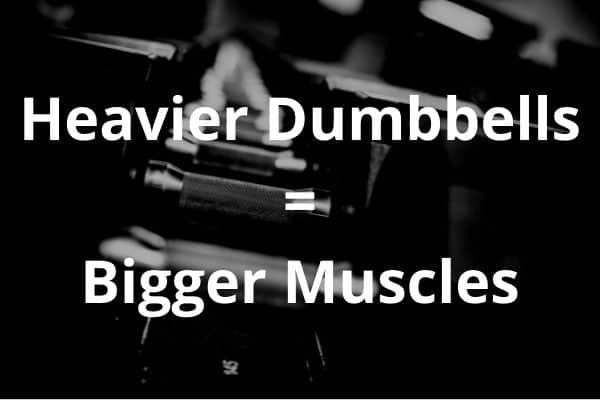
You could also increase reps. But after you reach 12 reps per set, you’ll need to start increasing weight and reducing reps again. Otherwise, you’ll begin training your muscles for endurance rather than size.
You can check out my other post to learn everything you need about rep max’s.
Similarly- you don’t want to do more than 5 sets per muscle per workout, as a 2018 study has shown diminishing returns after 5 sets (so-called “wasted sets”).
Therefore the best way to get big with dumbbells is to use progressively heavier dumbbells.
So how big can you get from dumbbell training?
Take a look at the diagram below to give you an idea of how much muscle you can expect to gain with dumbbells:
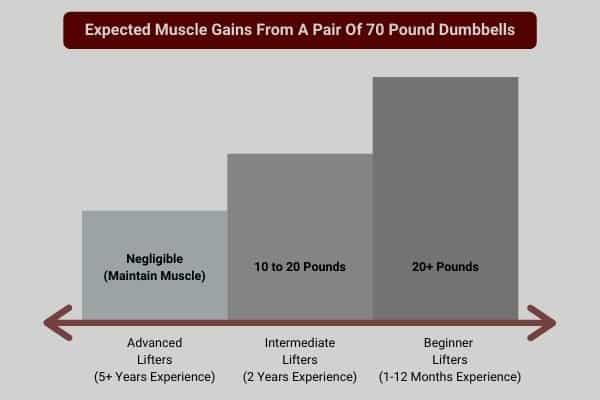
You should also note that the majority of your muscle gains from dumbbell training will be in the upper body.
Unlike the upper body, the lower body muscles are much larger (and stronger).
As such, they require heavier weights to provide a sufficient stimulus for growth.
So if you’re aiming to bulk up your legs, then you should invest in heavier dumbbells (70 pounds per dumbbell minimum).
So the next question is how heavy should you buy your dumbbells?
Read my other article to find out how much you should be lifting to build muscle!
What Dumbbell Weight Should You Get?
You should buy a dumbbell weight that is suitable for your current training level and allows you to reach your training goals. A pair of 70 to 90-pound adjustable dumbbells will allow beginner to intermediate-level lifters to build and maintain 10 to 25+ pounds of lean muscle.
Adjustable dumbbells can be as light as 30 pounds and as heavy as 90 pounds (per dumbbell). These are the maximum weight loads, but they also have adjustable weight increments
How heavy you choose depends on how much muscle you want to gain.
Take a look below to see what men look like at different muscle masses. This should give you an idea of how much muscle you need to gain.
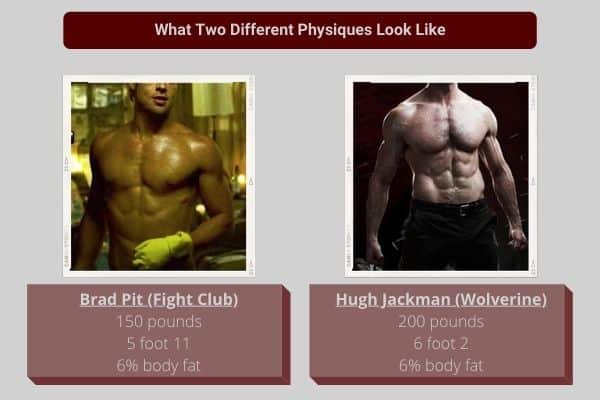
Next, you can determine how much YOU weigh and YOUR body fat %.
This allows you to figure out how much muscle you have (lean mass = weight – body fat %), and how much you need to gain to reach your goal.
You can determine your body fat % using a chart like this one from Train Beyond The Box.
Now you know how much muscle you NEED to gain, here’s how much you can EXPECT to gain as a beginner using different dumbbell weights:
| Dumbbell Weight | Estimated Muscle Gains |
|---|---|
| 30 to 55 pounds per dumbbell | 5 to 10 pounds |
| 55 to 70 pounds per dumbbell | 10 to 25 pounds |
| 90 pounds per dumbbell | 25+ pounds |
These are rough estimates and should be taken with a pinch of salt.
Your actual gains will ultimately be determined by your commitment, diet, and current muscle mass.
Generally speaking, I would advise you to get 90 pounds per dumbbell. These will last you for years and provide significant muscle returns.
But 70 pounds per dumbbell can also return significant muscle gains if you are on a tighter budget.
However, I’d stay away from anything less than 50 pounds per dumbbell. These won’t provide many returns, and you’ll probably need to upgrade them very quickly.
Check out my other article for home gym ideas with a dumbbell!
Powerblocks Are Versatile Dumbbells For Building Muscle

Having researched over 2 dozen dumbbell models, I found PowerBlocks to offer the best value for money, and the PowerBlock Elites to be the best of the different PowerBlock models.
The base model weighs 50lbs per dumbbell- this is great for beginners to begin training at home.
But the best thing about them is that they can be upgraded to 70lbs and 90lbs whenever you are ready (through separate addon kits).
Additionally, they give you all the weight increments you need for smooth progression.
If you’re looking for budget dumbbells, then the Yes4All spinlocks are also good for beginners.
Alternatively, you might also be interested in my best dumbbell recommendations for beginners here.
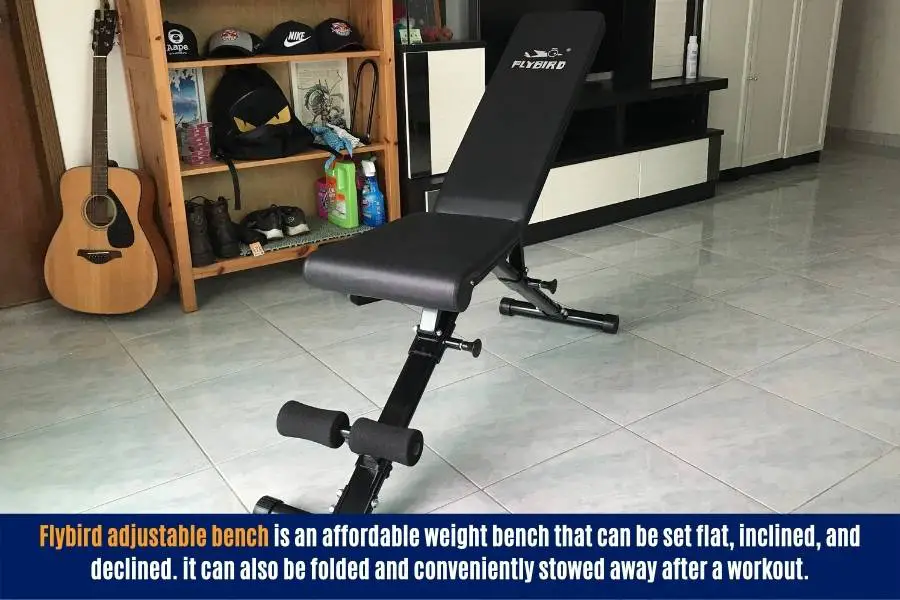
Both of the dumbbells mentioned above work great with the Flybird adjustable bench .
You can go here for my Flybird bench review.
Should You Train With Dumbbells every day?
It is not advisable to train with dumbbells every day. Regardless of your training goal, it is unnecessary to lift weights every day. You should instead lift dumbbells between 3 to 6 days per week, using a suitable training split that allows for you to reach your goal.
One concept you should understand is that muscle growth requires rest.
And it’s actually whilst you sleep and rest, that the muscle-repair process occurs.
This is why the training splits are so effective- they allow you to work and train all your muscles with the required weekly sets.
But they’ll also provide your muscles with the rest required to grow.
You could theoretically lift dumbbells every day. But you would be advised to lower your sets and reps to compensate for the increased number of training days.
Result?
You spend more time traveling to the gym, from the gym, and getting ready. All for not much-added benefit.
So there really is no point (unless you love living in the weight room).
if you’re looking to pack on some noticeable weight asap, then you can check out my guide on how to put on your first 10lbs in a 7 days!
Conclusion
That’s it!
Today I have explained why it’s completely possible to build muscle using only dumbbells.
However, you’ll need to choose a weight that is heavy enough to provide your muscles with the required levels of physical stimulus.
The weight of your dumbbells will also affect the amount of muscle you can build from your dumbbell training.
Take home message?
Choose a dumbbell weight that will allow you to reach your goals!
What weight dumbbells will YOU be choosing?
Let me know in the comments!
Alternatively, download the FREE Kalibre Muscle Blueprint PDF to find out EXACTLY how I transformed my skinny body as a hardgainer!
Thanks for reading guys!
Peace Out,
Kal
(Biochemistry BSc, Biomedical Sciences MSc, Ex-Skinny Guy)


